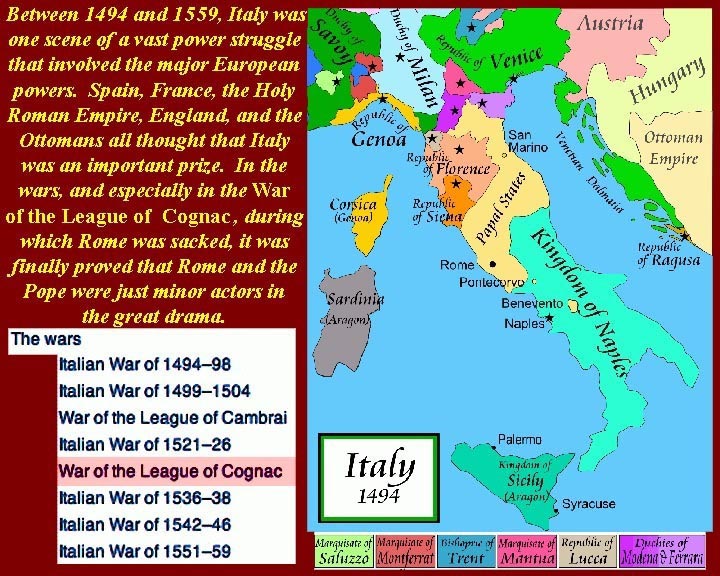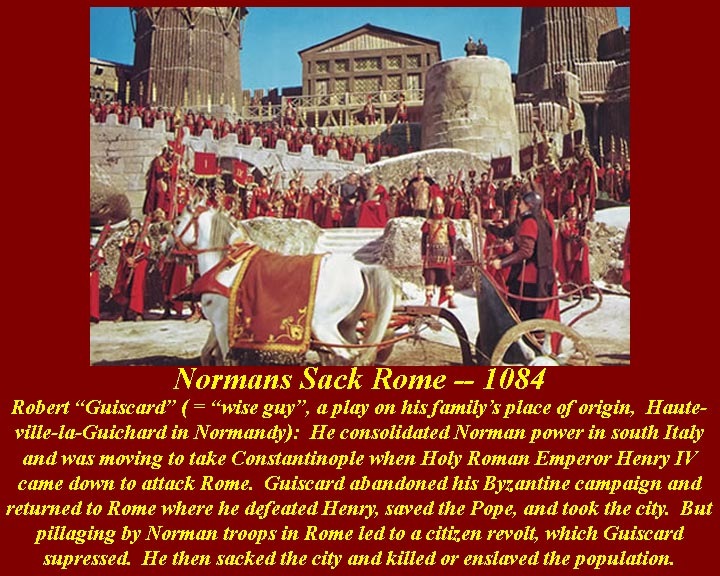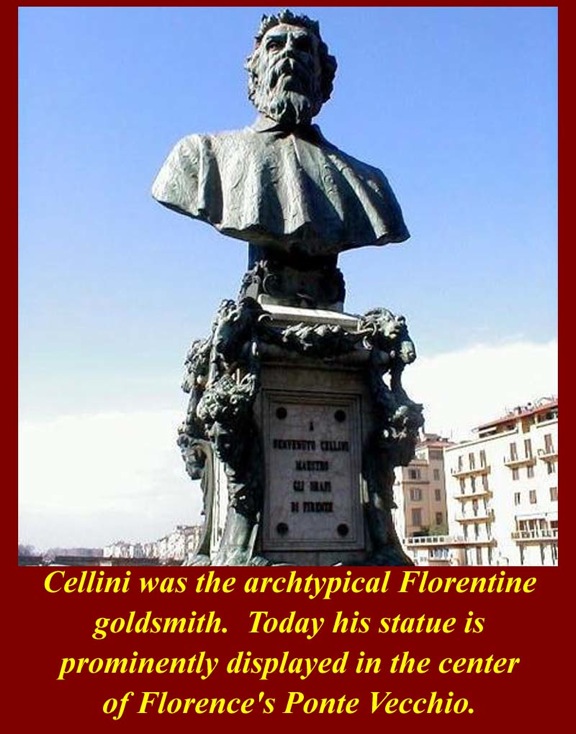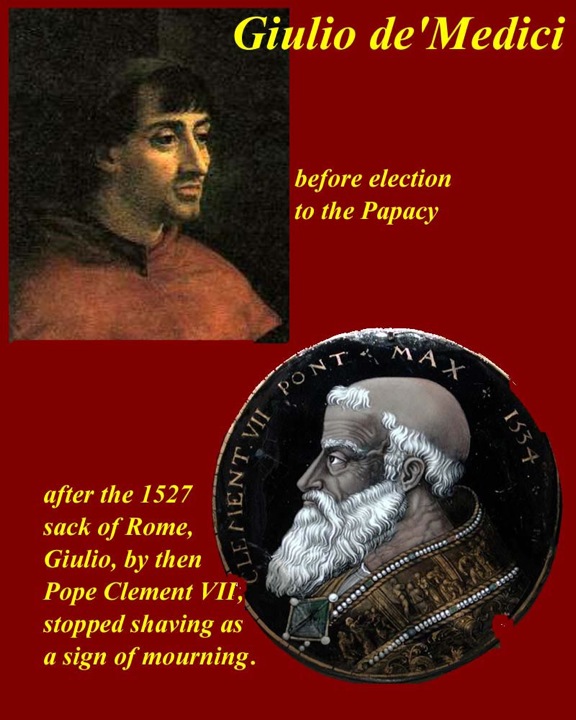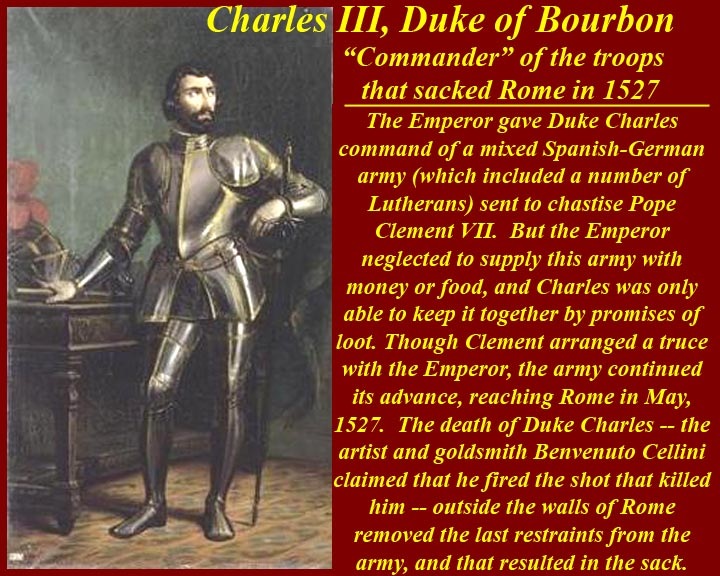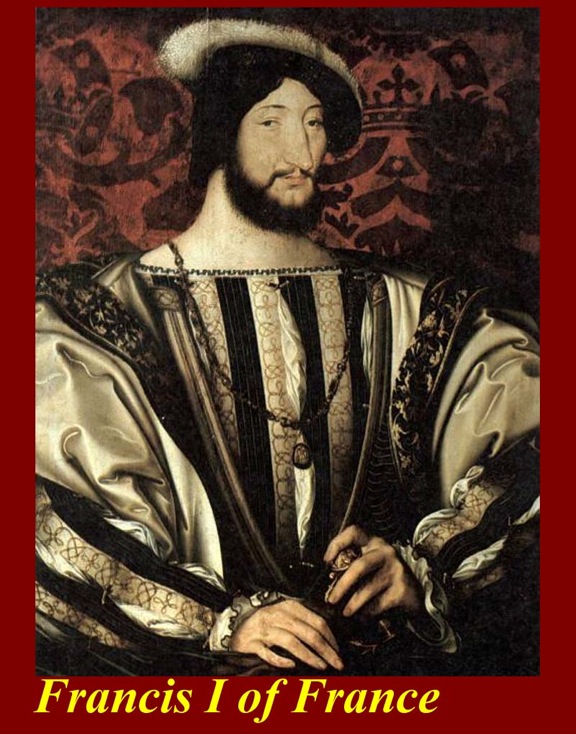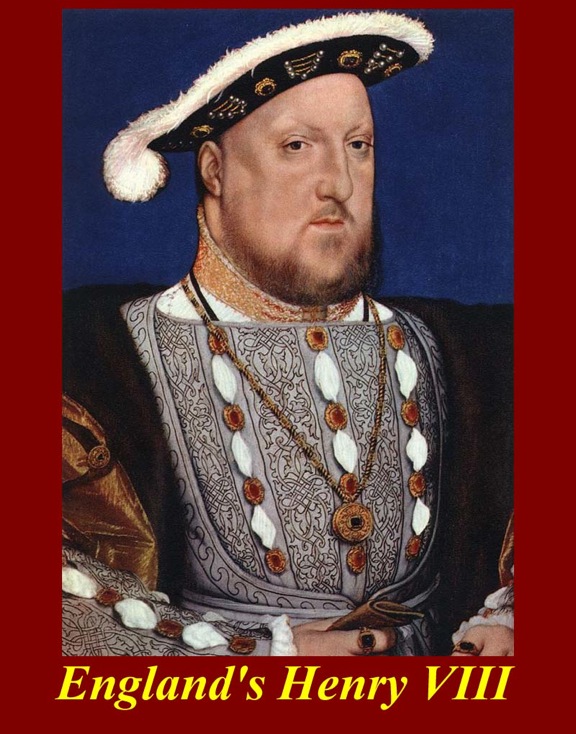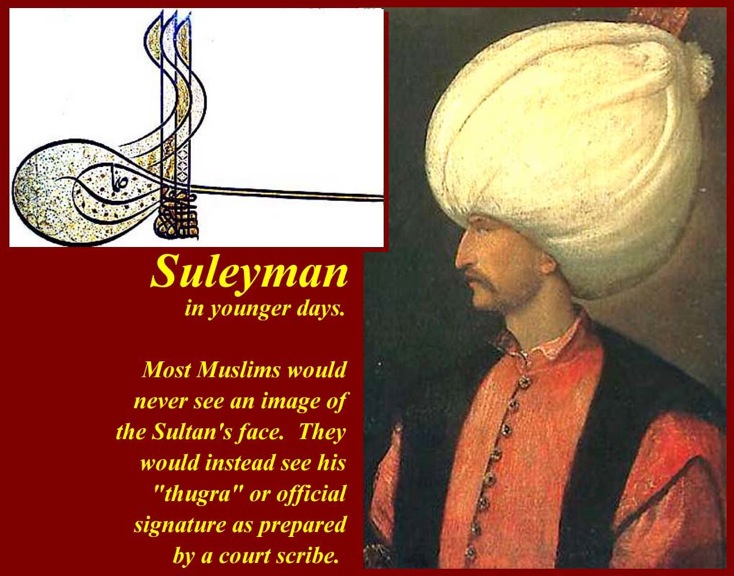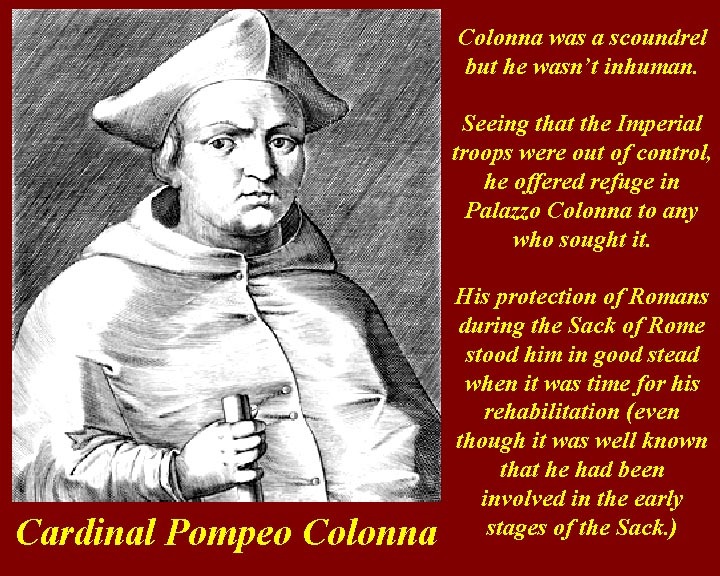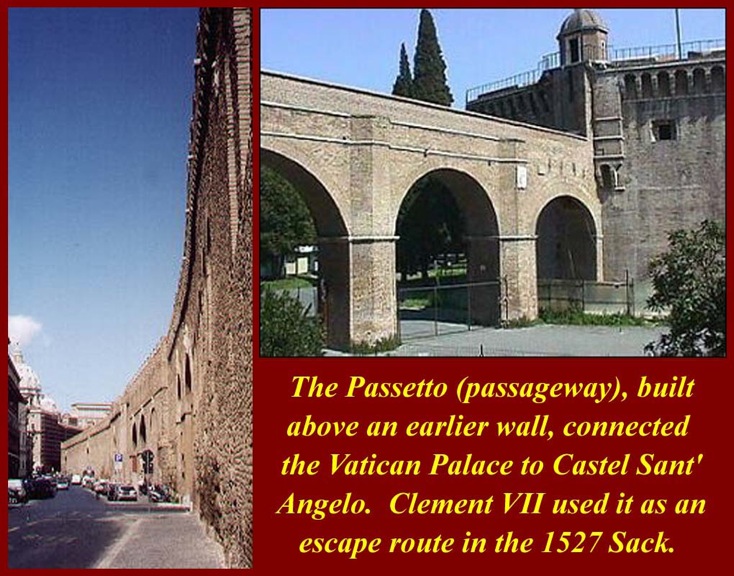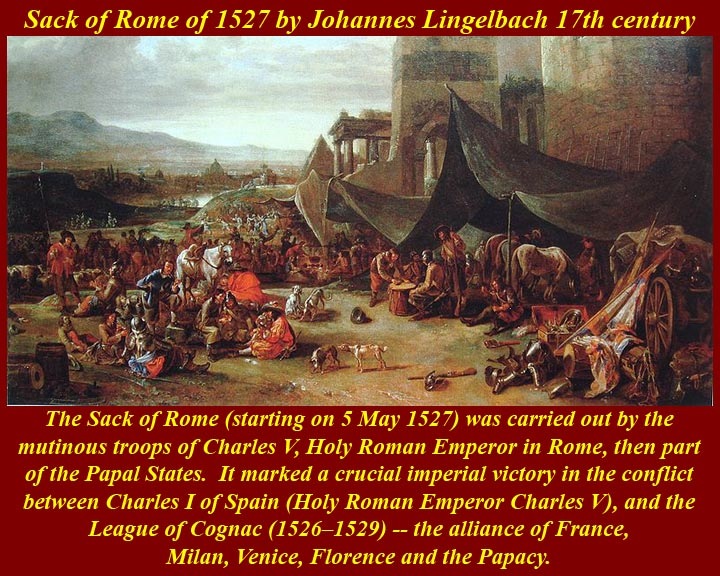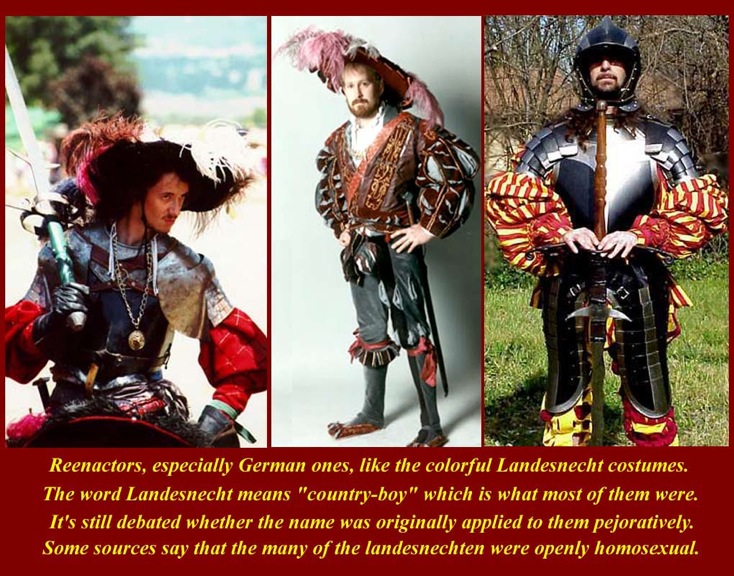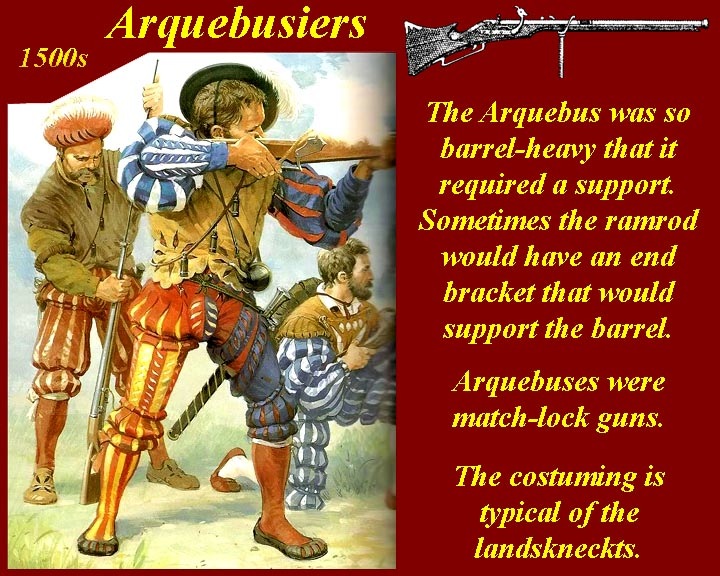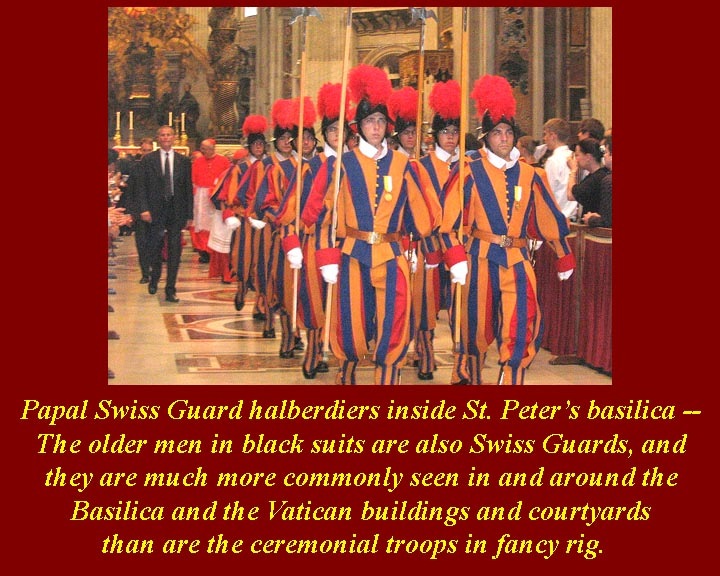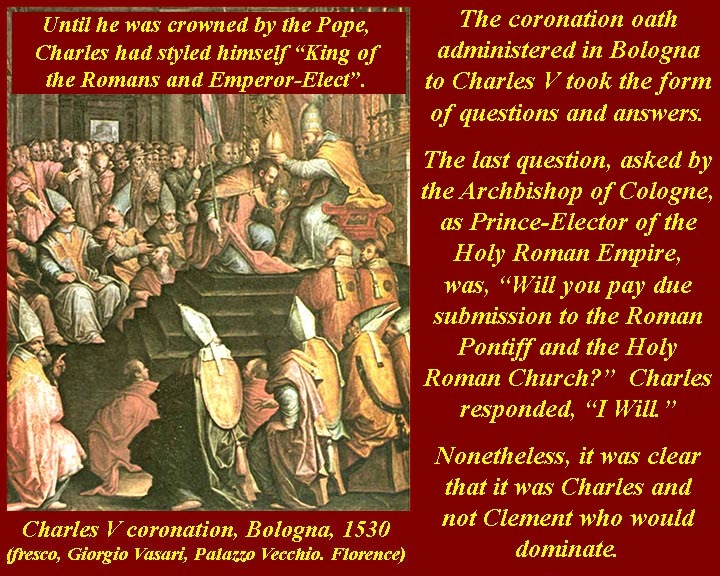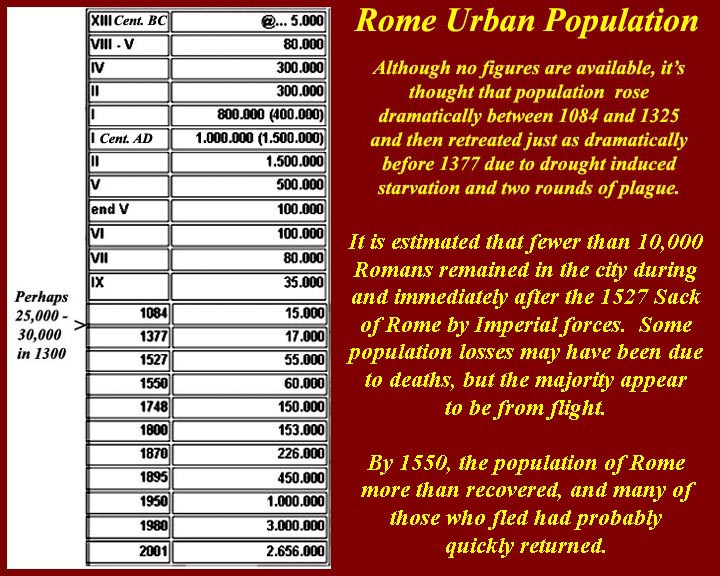The Sack of Rome -- 1527C.f., http://www.mmdtkw.org/VSackRome.html
Click Links or small images below to go to larger images for Unit 8.
http://www.mmdtkw.org/RenRom0800-Italy1494.jpg
The papacy's problems started years before: Europe's big powers, Spain, France, the Holy Roman Empire, England, and the Ottomans jostled each other for power and territory, and Italy, with its assortment of small states, offered some easily snatched territorial prizes. The popes, overestimating their own power and the power of alliances that they either crafted or joined, tried to expand their own power and territory on the Italian peninsula or at least to prevent or minimize losses. Some of the popes may have realized the danger involved, but their choices were limited: either play the game or watch passively while others nibbled away at papal power and territory. The popes played, and they made it through the first four wars, but then came the War of the League of Cognac. Unfortunately for the papacy, the incumbent pope at that time was the incompetent Clement VII Medici.
Money problems on other European fronts kept Holy Roman Emperor ("Elect" = not yet crowned) Charles VI from paying his troops in northern Italy, and their commander allowed the troops to start "foraging" for food and loot. They quickly got out of control and rushed toward Rome and "sacked" the poorly defended city.
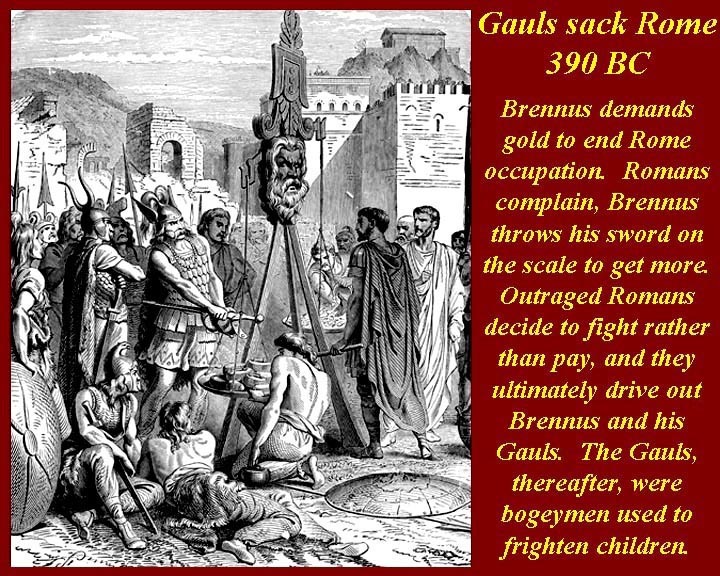
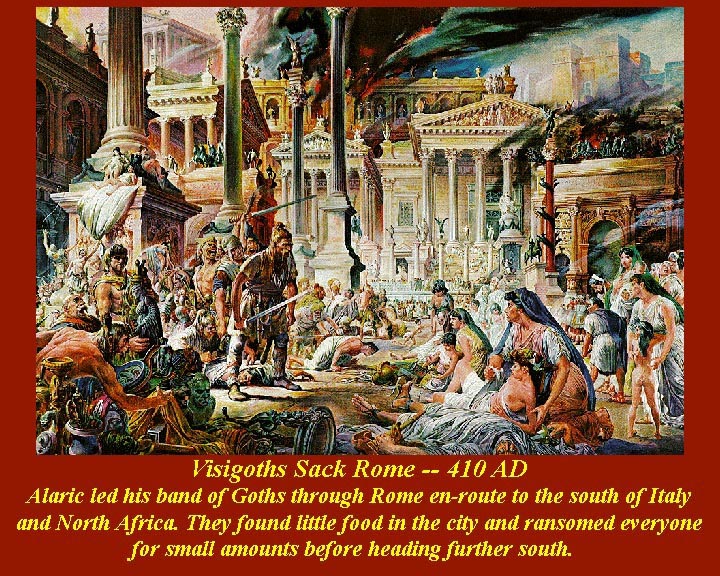
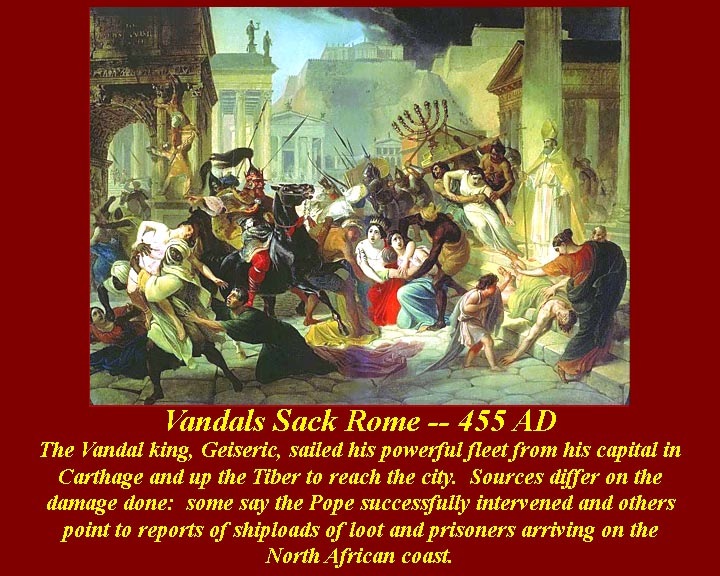
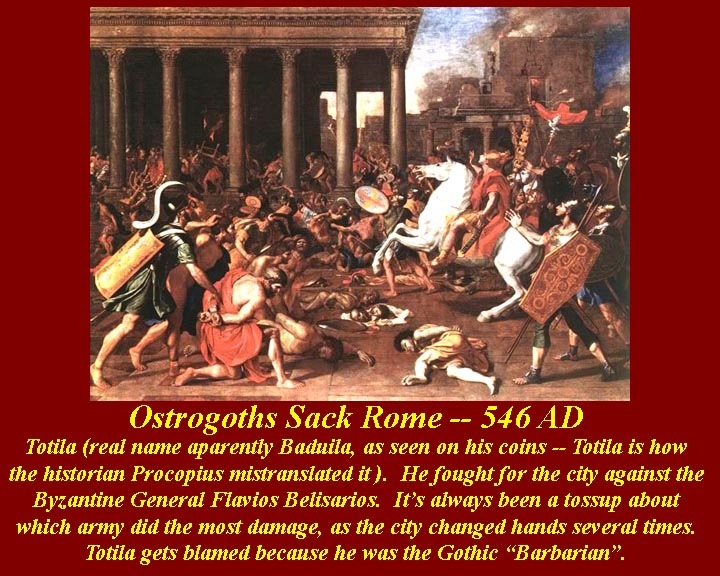
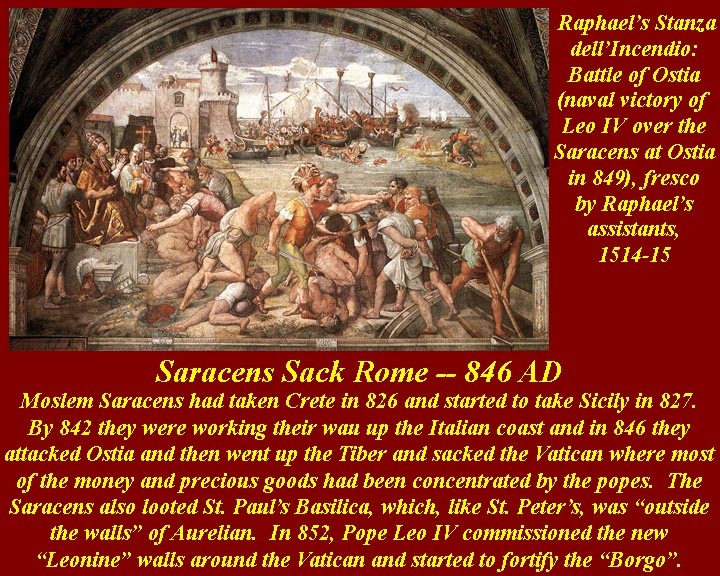
http://www.mmdtkw.org/RenRom0800a-390BCGaulsBrennus.jpg
http://www.mmdtkw.org/RenRom0800b-410ADAlaricVisigothSack.jpg
http://www.mmdtkw.org/RenRom0800c-455VandalsSack.jpg
http://www.mmdtkw.org/RenRom0800d-546OstrogothsSack.jpg
http://www.mmdtkw.org/RenRom0800e-846ADSaracensSack.jpg
http://www.mmdtkw.org/RenRom0800f-1084NormansSackRome.jpg
The Sack of Rome by the marauding troops of the Holy Roman Empire was not the first time that the city was looted. Six previous episodes are recorded.
In 390 BC Brennus led his Gauls south over the Alps and took the city demanding a large ransom for its release. The Romans balked at paying and eventually drove him out, but not before a lot of bloodshed, arson, rape, and looting. Until the end of the Western Roman Empire, the Gauls remained the bogeymen that Roman parents used to frighten their children into submission -- "If you do that, the Gauls will get you."
By 410 AD, Constantine had long ago departed Rome for his new capital, Constantinople, and had taken the Roman bureaucracy and, more importantly, its effective military forces along with him. This allowed barbarians to get easy access to the peninsula and to Rome itself. The first wave, the Visigoths, was led by a disaffected former Roman Army Auxiliary commander named Alaric. The weak Western emperor had failed to deliver on promises to Alaric and his Visigoths, so they moved on Rome. After a long siege, someone in the starving city opened the northern Salaria (now Pincian) Gate and the Visigoths poured in -- looking for food and loot. They found little food, of course, and left with what loot they had gathered through the southern gates only three days later -- slill looking for food.
They also took with them the sister of the Western Emperor (who was also the daughter of the Eastern Emperor) Galla Placidia. The Visigoths hoped to eventually get to North Africa, the breadbasket of the Empire. On their way south, true love happened, and Galla married Alaric. But Alaric died in southern Italy and the Visigoths headed back north (with Galla now on the arm of Atawulf [ = Adolph] the former second-in-command.) The Visigoths moved into southern France with Atawulf and his new bride, Galla, as monarchs in the Visigoth Kingdom (in Aquitaine). After Atawulf was murdered, Galla refused a proposal from his successor and returned to Italy where she married the Roman military commander. Her son became the next Western Emperor. For much more detail on Galla and her multi-generational imperial connections, see http://www.mmdtkw.org/VGallaPlacida.html. In 455, the Vandals came by sea from their headquarters in Carthage. They had originated centuries earlier in Scandinavia (yes they were Vikings) and worked their way down through Europe, crossed into Africa via Spain and Gibraltar, and then moved eastward along the North African coast until they stopped in the Carthage metropolis. They emulated the earlier Carthaginian Empire by becoming first sea traders, then commerce "regulators", and finally pirates. Their piracy included coastal raiding, and eventually, they sailed up the Tiber and sacked Rome. They took what they wanted and left. The Vandals, years later in 534 AD, had gotten so soft and comfortable in their North African haven that they were soon conquered by the Byzantines led by General Flavios Belisarios.
The next barbarian attack on Rome was in 546 when Totila led his Ostrogoth band south and took the city. By this time, the weak Western Emperors had evacuated to Ravenna and it fell to the forces of the Eastern Empire, led by Count Belisarios, who had been sent to dispute the Ostrogoth hold on the city. Rome changed hands several times over a period of a few years, and the Ostrogoths eventually were kicked out. Both the Ostrogoths and the Eastern Empire forces heavily damaged and looted the city when they held it in turn (and turn). But the successors of Belisarios eventually won, so all the damage and looting was blamed on the Ostrogoths sacking Rome.
A condensed history of Belisarios and his campaigns agains the Vandals and the Ostrogoths (and others) is available at http://en.wikipedia.org/wiki/Belisarius. Several "novelizations" have been written about the life of Belisarios, the best known of which is Count Belisarius by Robert Graves, who also wrote I, Claudius. Like I, Claudius, Count Belisarius has some glaring errors and strange interpretations, but, also like I,Claudius, it's a good read. The Saracens came in 846. Moslems had conquered North Africa in the 7th century and by 846 they, like their Vandal and Carthaginian forebears, turned to sea and coastal piracy. They conquered Malta and then Sicily and began moving up the western coast of the Italian peninsula. By 846 they were in Ostia and movong upriver to Rome. Previously, the papal authorities had concentrated the wealth and relics from Rome's churches to the Vatican "for safety", but that just made it easier for the Saracens to carry the wealth off in large quantities; the Vatican was outside of the Aurelian Walls that surrounded municipal Rome. (What could the papal authorities have been thinking?) The Saracens, as it turned out, didn't even try to penetrate the Aurelian Walls, having taken everything they wanted from the Vatican and from the Basilica of St. Paul, which was also "extra muros" ( = outside the walls). The Saracens left after their raids without doing serious damage, although some reports said that they arrived back in North Africa with shiploads of loot and slaves.
Closing the barn door after the horses are out: The Leonine Wall, which defines the Leonine City, was constructed following the sack of Old St. Peter's Basilica by Saracens in 846. Built from 848 to 852 as the only extension ever made to the walls of Rome, the three-kilometre wall encircled the Vatican area (Civitas Leoniana). An abortive start had been made by Leo III, but disturbances in the city over the cost of the new walls had suspended work, and the good citizens of Rome had dismantled the sections that had been begun and used them in private construction. In 1084, Robert Guiscard, who had earlier consolidated Norman power in southern Italy and was embarked on an expedition toward Constantinople, came back to Italy to save Pope Gregory VII from an attack by Holy Roman Emperor Henry IV. Guiscard's forces occupied the city and (being the displaced Vikings that they were -- yes, Vikings again: Norman = Norsemen) then ran riot. This led to a citizen revolt and a Norman sack of the city; the Roman citizens were killed or enslaved. Henry fled northward and Guiscard took the now very unpopular Pope to safety in Salerno.
Guiscard then resumed his campaign to take Constantinople. He defeated a Venetian fleet to recover Corfu, but died of a fever at Kephalonia.
Guiscard's name, which means "wise guy" (really!) was a play on the name of his family's place of origin, Haute ville la Guichard.
All of this by way of prelude to the 1527 Sack of Rome
-------------------------------------
How do we know what we know?
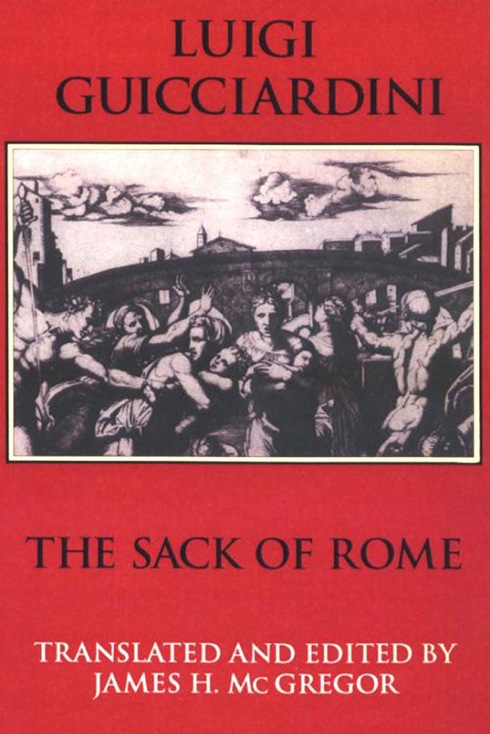
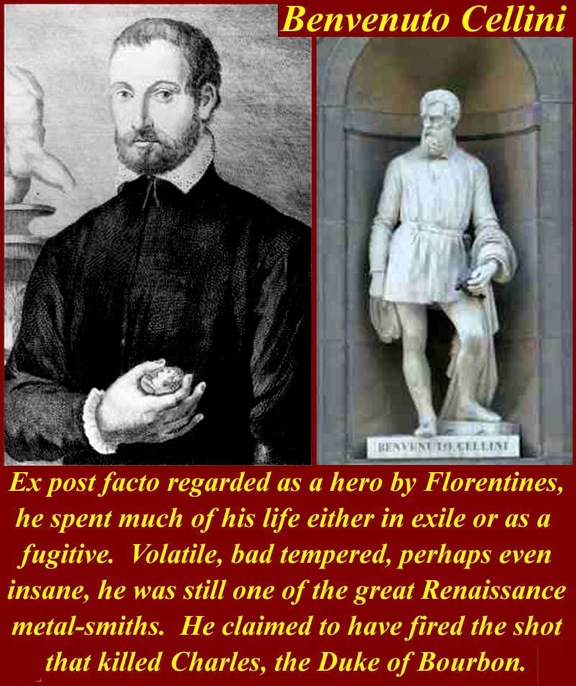
http://www.mmdtkw.org/RenRom0801-Guicciardini.jpg
http://www.mmdtkw.org/RenRom0802-Cellini1.jpg
http://www.mmdtkw.org/RenRom0803-Cellini2.jpg
How do we know what we know? It turns out that a well known and reliable historian was present for the Sack of Rome by the Imperial forces; Luigi Guicciardini wrote a vivid contemporary account of the Sack.
Also present, but a much less reliable reporter, was the goldsmith/metalsmith and adventurer Benvenuto Celini. He had been hired on by Clement VII for two jobs: he was to cast cannon from bronze from melted down statuary, and he was to melt down papal treasure (altar goods and papal jewelery) to make it easier to hide. Gemstones were to be salvaged and sequestered. Because of his cannon-making expertise, he was, by his account, given command of the defense of Castel Sant'Angelo. He wrote up his adventures diring the Sack as part of his famous autobiography. We have no way of knowing which parts of his account, if, indeed, any parts, are factual. Many other claims in his autobiography are patently false, so his Sack episodes may also be highly fictional. We do not, for example, know that the boastful Cellini was really in charge of the Castel Sant'Angelo defense. We do have evidence that he was present, but it is in the form of an indictment for stealing some of those sequestered gems and hidden gold. He claimed in his autobiography that he had confessed to the Pope that he had found about one and one-half pounds of gold (worth about 140 ducats) in the ashes of the fire he used to melt the Pope's gold and had taken it with every intention of paying it back to cover his expenses and "to comfort his poor old father. He said the Pope absolved him."
Cellini was a well known sociopath and was almost constantly in hiding or on the run from the Florentine authorities as a thief, a rowdy, and a serial killer (five, by his own account). He also was convicted of sodomy. Now he is idolized as the "patron saint" of the gold market on the Florence Ponte Vecchio -- fitting, since any tourist can tell you that the merchants there are cut from the same pattern as Cellini was. Cellini claimed to have fired the crossbow, whose bolt penetrated the eye and brain of Charles III, Duke of Bourbon. The death of Charles removed any restraint there might have been on the behavior of the Imperial forces, so we can blame the sack on Cellini. He would have loved it.
Players in the Drama:
http://www.mmdtkw.org/RenRom0804-ClementVIIMedici.jpg
Pope Clement VII Medici was just not able to compete either intellectually or militarily with the big powers that were grabbing pieces of Italy. The Sack of Rome and his imprisonment in the Castel Sant'Angelo (for six months, including the month before he surrendered) proved to the world and probably to him that he and everyone else in Italy were simply outclassed.
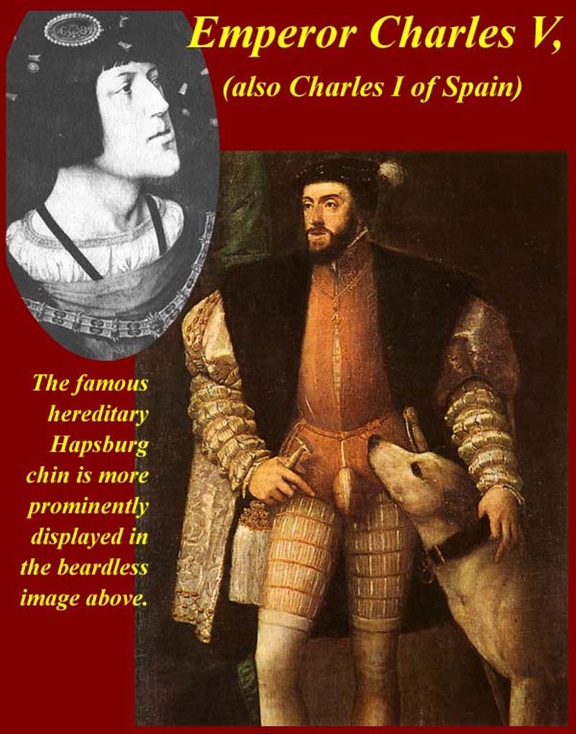
http://www.mmdtkw.org/RenRom0805-CharlesV.jpg
Charles V Hapsburg, Holy Roman Emperor (Elect) was also Charles I of Spain. For Charles, Italy was only a side-show as proved by the fact that he failed to even fund his armies headquartered in Milan. That lack of funding is what set those armies on the road to plunder, first in northern Italy and eventually (and ultimately embarassingly) in
Rome. Although Charles clearly had not planned that his mutinous troops should sack Rome, he probably was gratified that the Pope had been taken down a notch. Within three years, that same Pope had to appeal to Charles to use those same forces to reinstate the Medici in their home city of Florence. Shortly thereafter, Charles got the official coronation by the Pope that he had hoped for. He could now be Holy Roman Emperor without the "Elect" qualifier.
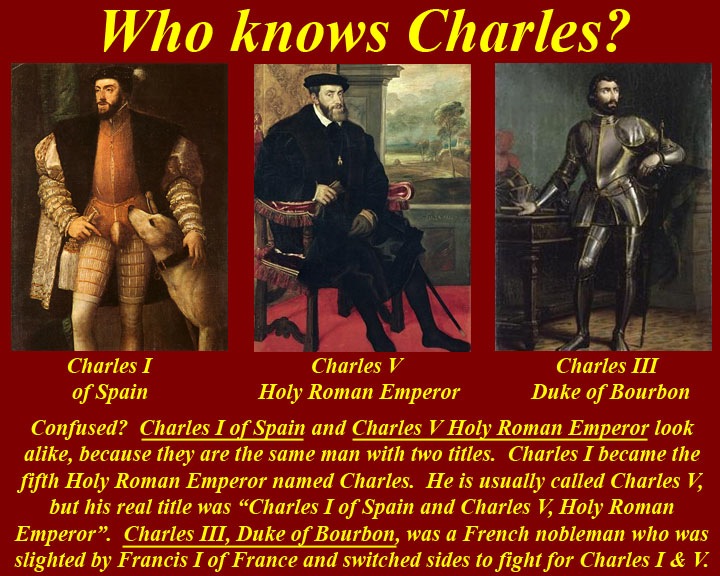
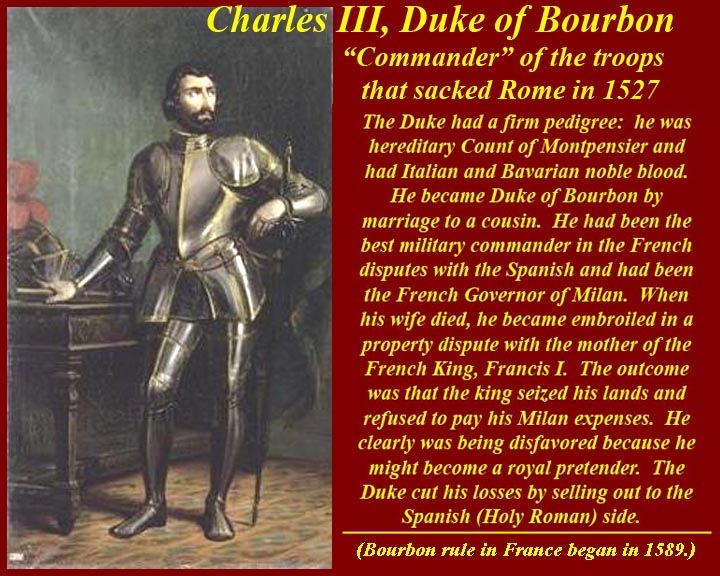
http://www.mmdtkw.org/RenRom0805a-WhoKnowsCharles.jpg
http://www.mmdtkw.org/RenRom0805b-CharlesIIIBourbon1.jpg
http://www.mmdtkw.org/RenRom0805c-CharlesIIIBourbon2.jpg
Just to make the situation more confusing, there was another Charles involved in the Sack of Rome. Charles III, the Duke of Bourbon, was a cousin of Francis I of France, and the two had literally grown up together. Francis made Charles his military commander, and Charles led French forces into Italy and became the French Governor of Milan. Trouble began between them Francis recalled the proud and wealthy Duke from Milan and refused to pay French bills there, for which Charles would then be responsible. A final break came when the wife of Charles, another Bourbon heir, died in 1521 and left all Bourbon properties in France to Charles. This meant that Charles was richer and more propertied than the King.
But the King's mother, Louise of Savoy, claimed the Bourbon properties as heir in proximity in blood, due to their previous entailments. She proposed to settle the property question by marrying Charles; but he refused her proposal (aparently insulting her looks in the process). On behalf of his mother, Francis then confiscated a portion of the Bourbon estates before the lawsuit had even been settled. Seeing no hope of prevailing, Charles made a secret agreement to betray his King and offer his services to Emperor Charles V.
The Emperor, Duke Charles III, and King Henry VIII of England devised a grand plan to partition France, which came to nothing; the plot was discovered and Charles was stripped of his offices and fled into Italy in 1523. In 1524, as commander of an imperial force in northern Italy, he drove the French under Bonnivet from Lombardy, and fought at the Battle of Pavia. The Emperor then gave Duke Charles command of a mixed Spanish-German army (which included a number of Lutherans) sent to chastise Pope Clement VII. He neglected to supply this army with money or food, and Charles was only able to keep it together by promises of loot. Though Clement arranged a truce with the Emperor, the army continued its advance, reaching Rome in May, 1527. The death of Duke Charles — the artist and goldsmith Benvenuto Cellini claimed that he fired the shot that killed him — outside the walls of Rome removed the last restraints from the army, which resulted in the sack of Rome.
http://www.mmdtkw.org/RenRom0806-FrancisIofFrance.jpg
Francis I (French: François Ier ), was King of France from 1515 until his death on March 31, 1547. He is considered to be France's first Renaissance monarch. In the larger picture he was allied with Suleyman, the Ottoman Emperor who was harassing the eastern edges of the Holy Roman Empire -- it was that pressing problem which drained money away from the imperial forces in northern Italy commanded by the Duke of Bourbon.
Charles V, at the same time, was courting the Safavids in Persia (Ismail I and Tahmasp I, leaders at the beginning of a new Turkic speaking dynasty that came from Azarbaijan, probably of Kurdish ethnicity). Distance and slow communications prevented a formal alliance between the Emperor and Persia, but the Persians did start to harass the Turks and took some pressure off the eastern edge of the Holy Roman Empire. In 1532, the first Ottoman-Safavid War broke out. It lasted until 1555, and four subsquent Turco-Persian wars spread out into the middle of the 18th century. See http://en.wikipedia.org/wiki/Turco-Persian_Wars.
http://www.mmdtkw.org/RenRom0807-Henry8.jpg
In 1520, King Henry VIII of England, his wife, Queen Catherine, and virtually the entire English court had traveled across the English Channel for a meeting with King Francis I of France, for the purpose of establishing a political alliance. The two monarchs were rivals, both politically and personally, and each prided himself on the splendor of his court.
The meeting was to take place between the villages of Ardres and Guines, near Calais, but as the castles at both villages were in very poor condition, separate camps were established for the French and English courts in fields near the villages--Henry's court at Guines, and Francis's court at Ardres.
For three weeks (June 7-June 24) the two courts strove to outdo each other on this "Field of Cloth of Gold" in displays of wealth and splendor. There were jousts and processions, masques, balls, banquets, sporting events, and even fireworks. The lavish expenditures nearly bankrupted both the French and the English treasuries, and yet the meeting between Henry and Francis proved to be of no political value. On June 25, the English court returned to Calais.
Two weeks later, King Henry met with the Holy Roman Emperor Charles V of Spain, who was Queen Catherine’s nephew. Catherine, who was after all a Spanish princess, had always favored an alliance with Spain rather than France, and had acquiesced only reluctantly when their daughter Princess Mary had been betrothed to Francis’s heir, the Dauphin of France. Now Henry concluded a treaty with Charles, with each agreeing not to make any new alliance with France for at least two years. Cardinal Wolsey arranged to have Mary’s betrothal to the Dauphin broken, and instead Mary was betrothed to Charles.
Two years later King Henry declared war on France, and his ally, the Emperor Charles, did likewise soon afterward. Nevertheless, by 1525, the betrothal between Mary and Charles had been broken also, and a new treaty had been arranged with France. Throughout his reign, King Henry continued to manipulate these two powerful monarchs, and continued to be manipulated by them, as each jockeyed for political ascendancy in Europe.
In 1527, while Clement VII was being held prisoner in Castel Sant'Angelo, Henry's emissaries reached the pope with Henry's request for his marriage to Catherine, the aunt of Charles V, to be annulled. Clement, by that time thoroghly cowed, refused to give Henry what he wanted, an unconditional annullment.
Henry's request was not without merit; Catherine had been, as Henry's petition said, betrothed to his brother who had died. The Pope did agree to a conditional dispensation (i.e., one that required further evidence and decision before annulment) but Thomas Wolsey told Henry that that would not be sufficient. Unconditional annulments had been (and continue to be) granted in more questionable circumstances, so we can conclude that the deciding factor for Clement was political (and survival) rather than religious.
Wolsey, ( c. 1474–1530) usually known as Cardinal Wolsey, incurred Henry's displeasure by failing to secure the papal dispensation necessary for Henry VIII’s divorce from Catherine of Aragon. He was arrested on a charge of treason and died on his way to trial.
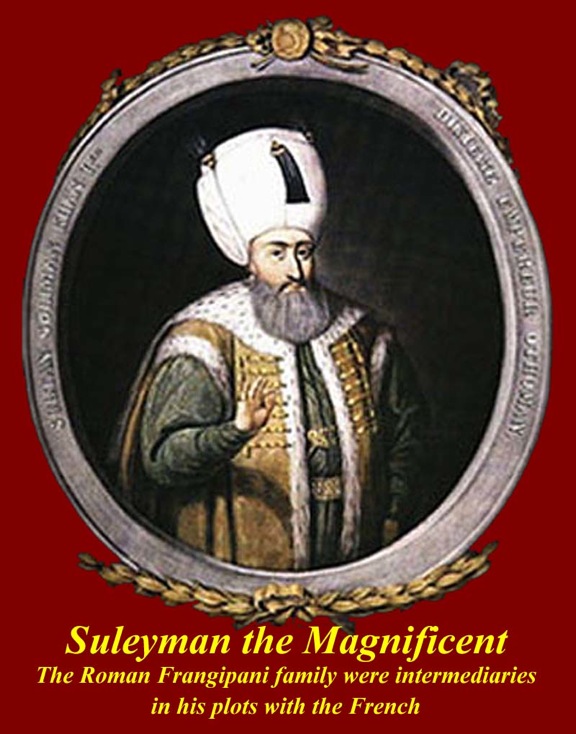
http://www.mmdtkw.org/RenRom0808-Suleyman.jpg
http://www.mmdtkw.org/RenRom0809-SuleymanThugra.jpg
"...Suleyman in his time was regarded as the most significant ruler in the world, by both Muslims and Europeans. His military empire expanded greatly both to the east and west, and he threatened to overrun the heart of Europe itself. In Constantinople, he embarked on vast cultural and architectural projects. Istanbul in the middle of the sixteenth century was architecturally the most energetic and innovative city in the world. While he was a brilliant military strategist and canny politician, he was also a cultivator of the arts. Suleyman's poetry is among the best poetry in Islam, and he sponsored an army of artists, religious thinkers, and philosophers that outshone the most educated courts of Europe. The reign of Suleyman in Ottoman and Islamic history is generally regarded as the period of greatest justice and harmony in any Islamic state.... The Europeans called him "The Magnificent," but the Ottomans called him Kanuni, or "The Lawgiver"....
"...Suleyman was a major player in the politics of Europe. He pursued an aggressive policy of European destabilization; in particular, he wanted to destabilize both the Roman Catholic church and the Holy Roman Empire. When European Christianity split Europe into Catholic and Protestant states, Suleyman poured financial support into Protestant countries in order to guarantee that Europe remain religiously and politically destabilized and so ripe for an invasion. Several historians, in fact, have argued that Protestantism would never have succeeded except for the financial support of the Ottoman Empire.
"Suleyman was responding to an aggressively expanding Europe. Like most other non-Europeans, Suleyman fully understood the consequences of European expansion and saw Europe as the principle threat to Islam. The Islamic world was beginning to shrink under this expansion. Portugal had invaded several Muslim cities in eastern Africa in order to dominate trade with India, and Russians, which the Ottomans regarded as European, were pushing central Asians south when the Russian expansion began in the sixteenth century. So in addition to invading and destabilizing Europe, Suleyman pursued a policy of helping any Muslim country threatened by European expansion. It was this role that gave Suleyman the right, in the eyes of the Ottomans, to declare himself as supreme Caliph of Islam. He was the only one successfully protecting Islam from the unbelievers and, as the protector of Islam, deserved to be the ruler of Islam...." (Exerpted from http://www.wsu.edu:8080/~dee/OTTOMAN/SULEYMAN.HTM [now a dead Internet link, and the text has been appropriated on a number of Internet sites.])
In Europe, Süleyman was known as the Magnificent, a recognition of his prowess by those who feared him most. He had great victories along the fringes of Europe in territories also coveted by Charles V. Belgrade fell to Süleyman after a siege in 1521. The next year the Christians were compelled to abandon the Greek island of Rhodes. In 1526 Ottoman forces killed the king of Hungary and the flower of the Magyar nobility at the Battle of Mohács and took Buda on the Danube. Vienna was besieged unsuccessfully during the campaign season of 1529. North Africa up to the Moroccan frontier was brought under Ottoman suzerainty in the 1520s and 1530s, and governors named by the sultan were installed in Algiers, Tunis, and Tripoli. In 1534 Kurdistan and Mesopotamia were taken from Persia. The latter conquest gave the Ottomans an outlet to the Persian Gulf, where they were soon engaged in a naval war with the Portuguese. Ottoman forces confronted those of the Charles V along the Danube and at sea in the western Mediterranean. In 1536 Süleyman I's diplomats concluded a treaty with Francis I of France, the Habsburgs' European rival, which granted the French commercial concessions in the Ottoman Empire in return for an informal alliance against their common enemy. (For years, Jean Frangipani, a Croat probable cognate of the Roman Frangipani family had been the go-between for the French and Ottoman courts.)
When Suleyman died while on a campaign in Hungary in 1566, the Ottoman Empire was a major world power. Most of the great cities of Islam -- Mecca, Medina, Jerusalem, Damascus, Cairo, Tunis, and Baghdad -- were under the sultan's crescent flag. The Ottoman Porte exercised direct control over Anatolia, the Balkan provinces south of the Danube River, Syria, Palestine, and Mesopotamia. Egypt, Mecca, and the North African provinces were governed under special regulations, as were satellite domains in Arabia, in the Caucasus, and among the Crimean Tartars. In addition, the native rulers of Wallachia, Moldavia, Transylvania, and Ragusa (present-day Dubrovnik) were vassals of the Suleyman.
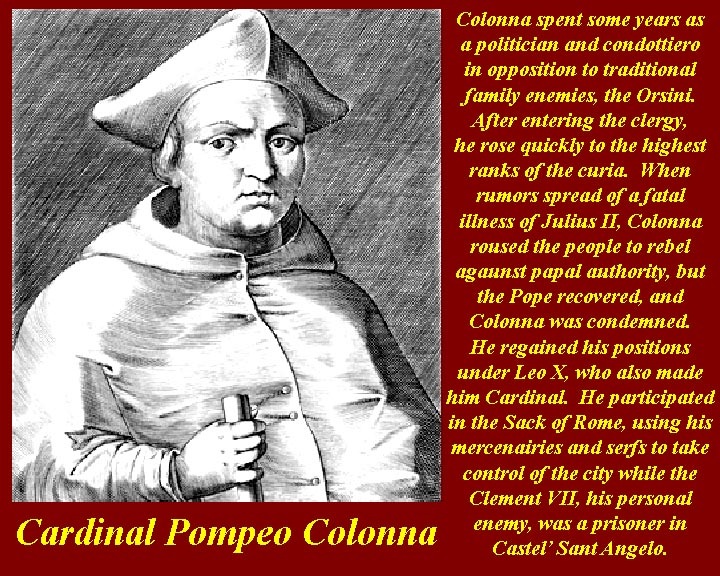
http://www.mmdtkw.org/RenRom0809a-PompeoColonna1.jpg
http://www.mmdtkw.org/RenRom0809b-PompeoColonna2.jpg
Colonna was a bit player in the larger drama, but his presence was felt in Rome. In 1526, the year before the Sack, he reportedly led a mob that broke into the Vatican and stole gold from the altars and sacristy of St. Peters.
He was a protagonist in the Sack of Rome, when, with a group of mercenaries and peasants from Colonna fiefs in the countryside, he took part in the sack and assumed control of the city while his personal enemy, pope Clement VII, was a prisoner in Castel Sant'Angelo. His initial participation in the Sack was partially redeemed when he opened Palazzo Colonna and offered his protection to Romans fleeing the depredation and violence of the Imperial forces.
He was later legate in Ancona and archbishop of Monreale. In 1530 he was created general lieutenant of the Kingdom of Naples by Emperor Charles V.
Colonna was also a poet. His most famous work is De laudibus mulierum, written for his relative Vittoria Colonna.
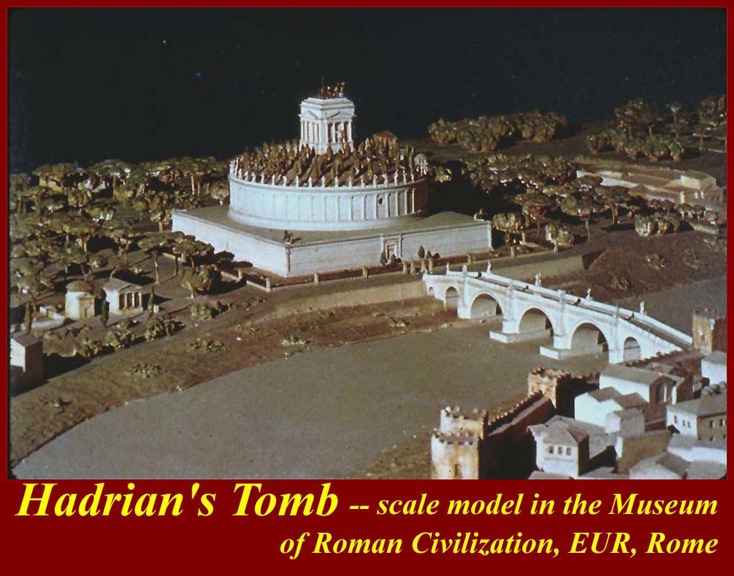
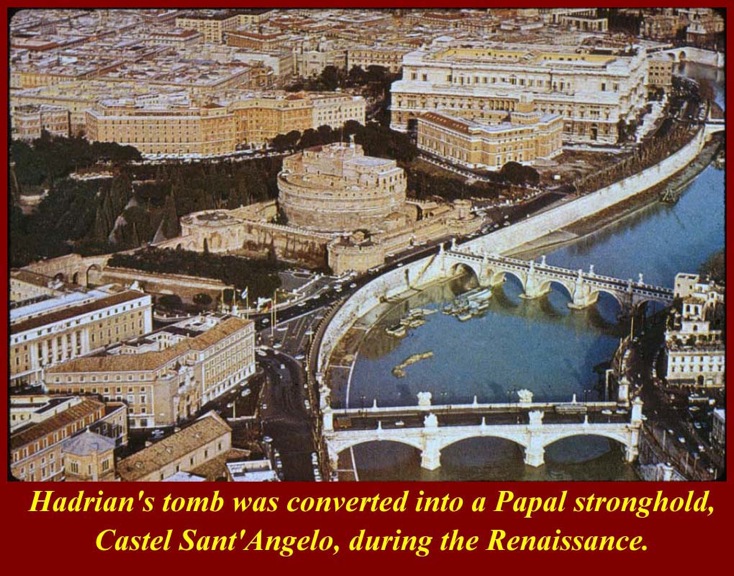
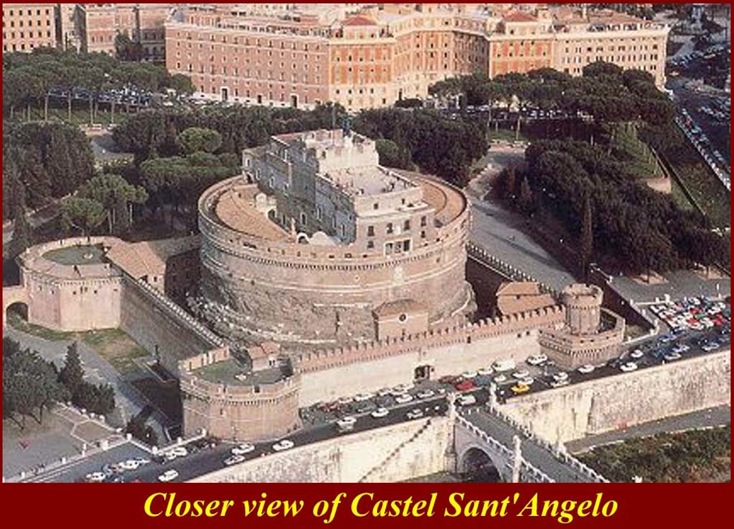
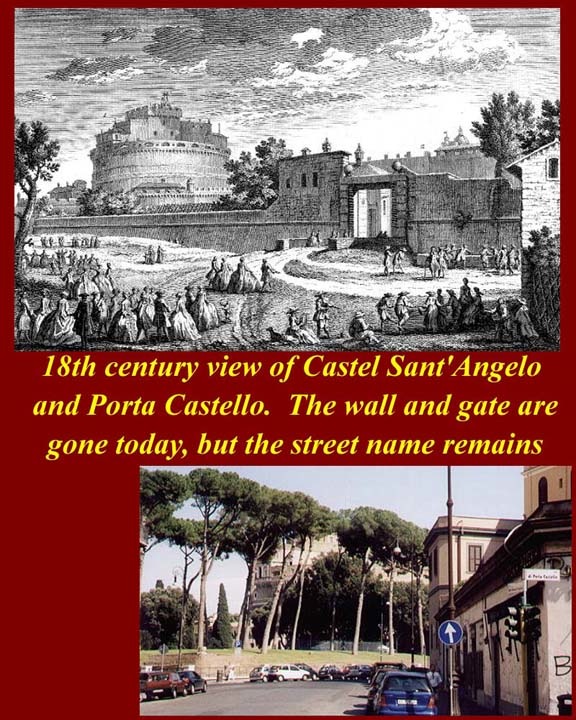
http://www.mmdtkw.org/RenRom0810-HadrianTomb.jpg
http://www.mmdtkw.org/RenRom0811-CastelSAngelo1.jpg
http://www.mmdtkw.org/RenRom0812-CastelSAngelo2.jpg
http://www.mmdtkw.org/RenRom0813-CastelSAngelo3.jpg
http://www.mmdtkw.org/RenRom0814-Passetto.jpg
Castel Sant'Angelo was originally built as a tomb for Hadrian (died 138) and was then was also the site of the entombment of a number of his successors until the time of Caracalla (died 217 AD). The building was converted into a military fortress in 401 by Western Emperor Honorius to guard the Vatican end of the Pons Aelius (now Ponte Sant'Angelo). By 1427 it was very much as it is today except that it was surrounded by an additional low wall with a fortified gate.
When the Imperial troops attacked on May 6, 1527, Pope Clement's initial intention was to try to face them down in the Vatican. But he quickly realized they were out of control and fled through the Passetto, the safety escape passageway built in 1277, to Castel Sant'Angelo. The fortress was not taken during the 1527 Sack, but after one month the Pope officialy surrendered himself to imprisonment in the Castel. (This allowed resupply of comestibles, water, and other supplies and stopped exchanges of fire.)
Clement was kept as a prisoner in Castel Sant'Angelo for six months. After bribing some Imperial officers, he escaped disguised as a peddler, and took shelter in Orvieto, and then in Viterbo. He came back to a depopulated and devastated Rome only in October 1528.
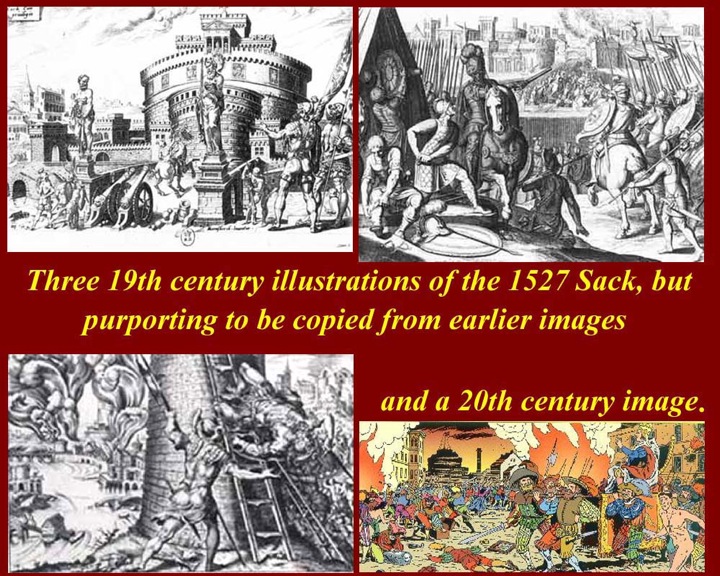
http://www.mmdtkw.org/RenRom0815-SackImages.jpg
http://www.mmdtkw.org/RenRom0815a-1527Sack-JohannesLingelbach17thC.jpg
There are no surviving eyewitness images of the events in Rome during the Sack of 1527. Several artists drew and painted scenes based on description or on earlier images that did not survive.
Fighting forces
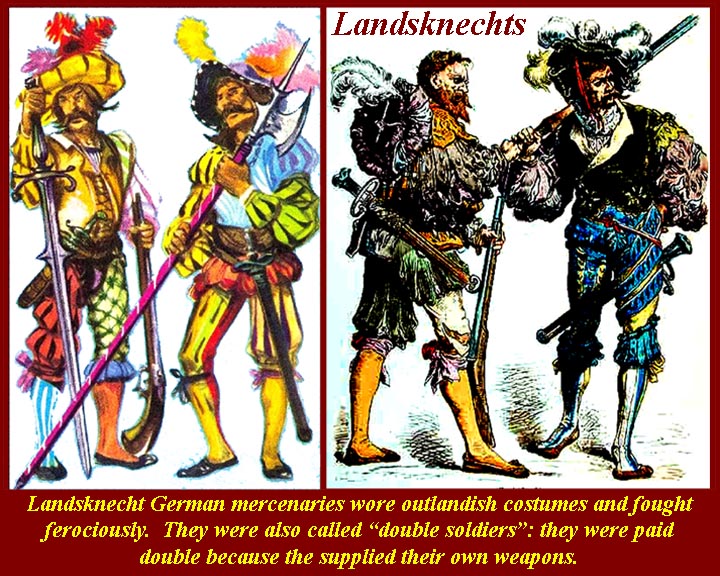
http://www.mmdtkw.org/RenRom0816-Landesnechten1.jpg
http://www.mmdtkw.org/RenRom0817-Landesnechten2.jpg
In addition to Catholic regular Spanish troops, Charles III, Duke of Bourbon, had a large number of Lutheran German mercenary landsknechts in his force. These mercenaries provided their own uniforms and weapons and were also known in German as "double soldiers". Originally they were all just unattached mercenary pikemen (literally "freelancers"), but by the time of the sack they carried a variety of arms including the new personal gunpowder weapon, the harquebus (also arquebus, arquebut and several additional name variations.) The word "landsknecht" meant that the were men of the (flat) lands, as opposed to mountaineers ("montagnards") like the Swiss mercenaries who were also on the market. Generally speaking, the Swiss montagnards worked for the French and the Papacy and German Landsknechts worked for the Spanish and Holy Roman Empire Hapsburgs.
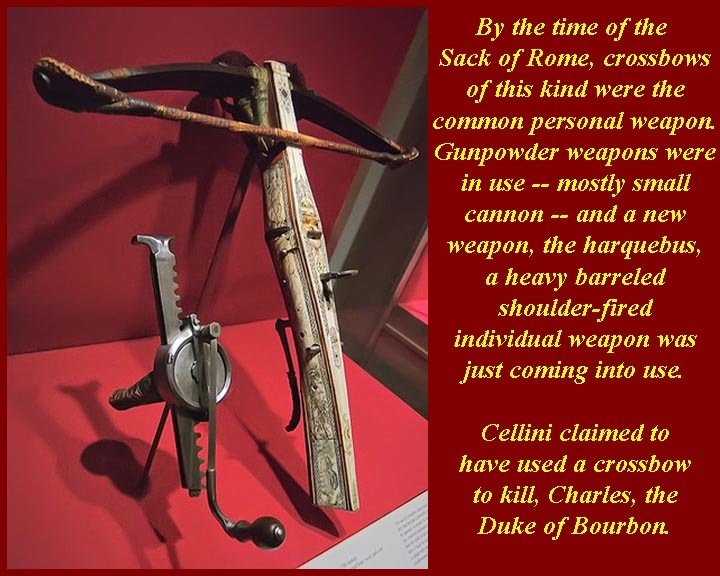
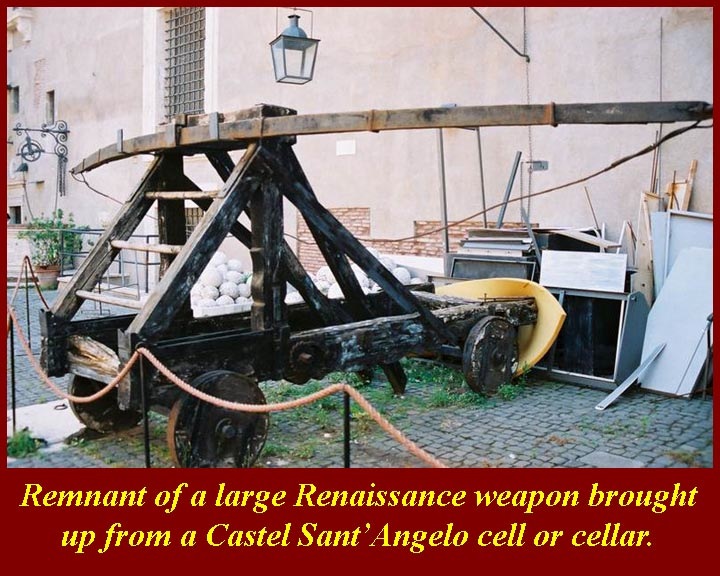
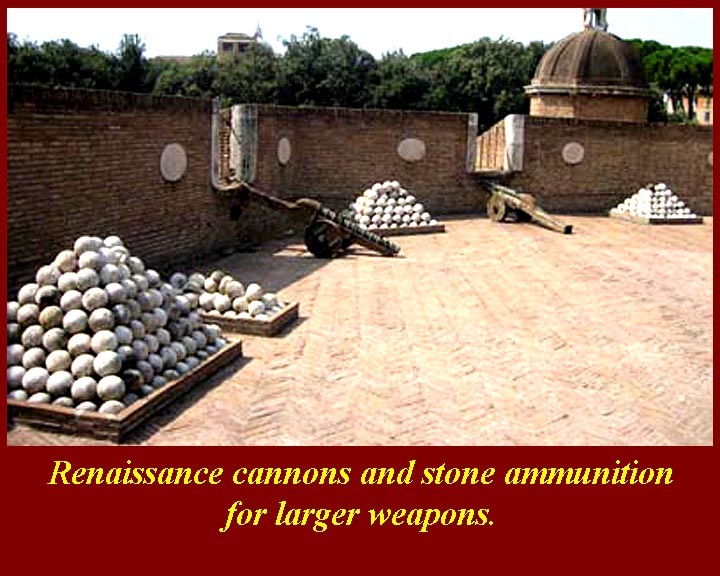
http://www.mmdtkw.org/RenRom0818-Crossbow.jpg
http://www.mmdtkw.org/RenRom0818a-WeaponLg.jpg
http://www.mmdtkw.org/RenRom0818b-SantAngeloGunsAmmo.jpg
http://www.mmdtkw.org/RenRom0819-Arquebus.jpg
Most of the attackers and the defenders were equipped with blade weapons -- swords, lances, halbards, axes -- but some also could fight at a distance using crossbows and Arquebusses. The attackers had abandoned their artillery, both mechanical and gunpowder. Both types of artillery were available to the defenders of Castel Sant'Angelo.
A form of the word "artillery" first appeared in French and is assumed to come from a Latin root. Its first meaning referred to the projectiles rather than the engines that launched them. Use of "artillery" in the sense of "mechanical engines for discharging missiles" (catapults, slings, bows, etc.) is from the late 15th century, and its use to mean "ordnance / large guns" is from 1530s.
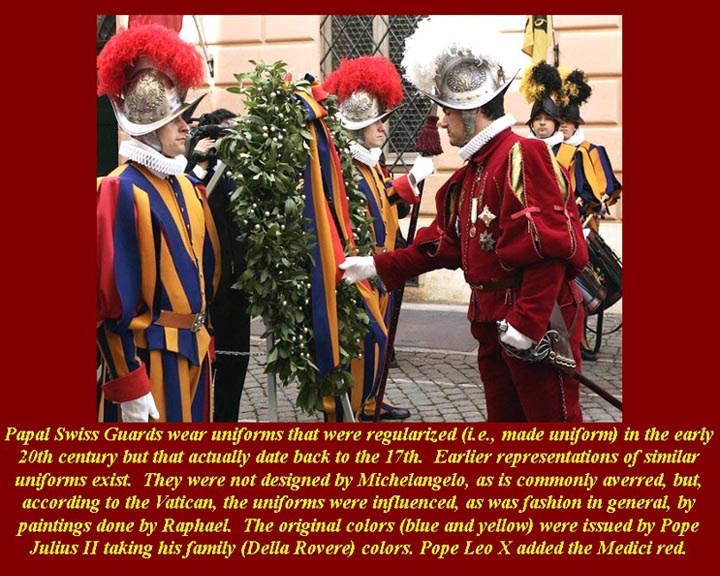
http://www.mmdtkw.org/RenRom0820-SwissGuards1.jpg
http://www.mmdtkw.org/RenRom0820a-SwissGuards2.jpg
The Papal Swiss Guards (official title, Corps of the Pontifical Swiss Guard) are montagnards and were already on duty at the time of the Sack of Rome in 1527. Pope Sixtus IV (1471-1484) had made the first alliance with the Swiss Confederation and built barracks in Via Pellegrino after foreseeing the possibility of recruiting Swiss mercenaries. The upper storey of the fortified Sistine Chapel was also designed as a barracks and guard station for the Swiss Guards. (Their current quarters are just to the east of the Pope's residence on the north side of St. Peter's Square.) The Popes used Swiss montagnards in several engagements before the Sack of Rome -- sometimes (during the papacies of the Borgias) against other montagnards, who fought for the French.
Julius II set up a permanent force of 150 Swiss mercenaries in 1506, the beginning of the current Swiss Guard force. Its first, and most significant, hostile engagement was on May 6, 1527 when 147 of the 189 Guards, including their commander, died fighting the unruly troops of Holy Roman Emperor Charles V during the Sack of Rome in order to allow Clement VII to escape through the Passetto di Borgo, escorted by the other 40 guards.
The Vatican internet site states that the uniform of the Swiss Guards was designed in 1914 by Commandant (1910-1921) Jules Repond, but a painting (by Raphael) of the Swiss Guard bearing Pope Julius II on a litter is often cited as inspiration for the Swiss Guard uniform. The uniforms worn by those soldiers appear to have a large skirt or very broad knee pantaloons. The yellow and blue colors are those of the Della Rovere family of Julius and the red flashes were added by the Medici to reflect their own family colors. Enlisted personnel wear the multi-colored uniforms and officers wear solid scarlet for ceremonial occasions. Many sources claim that the multi-colored uniform of the Swiss Guard enlisted men was designed by Michelangelo, but the Vatican says that it was costumes in paintings by Raphael (not Michelangelo) that influenced the uniform design and also influenced fashion of the period. A plain blue version of the uniform is used for regular duty, and a dark blue long cape is used in inclement weather. The "men in black"-- black suits, white shirt, dark blue tie -- that are seen standing around the doors and inside of St. Peters and in the Vatican Museums are also Swiss Guards.
An short "official" English language history of the Pontifical Swiss Guards is available at the Vatican internet site, http://www.vatican.va/roman_curia/swiss_guard/swissguard/storia_en.htm.
Aftermath of the Sack
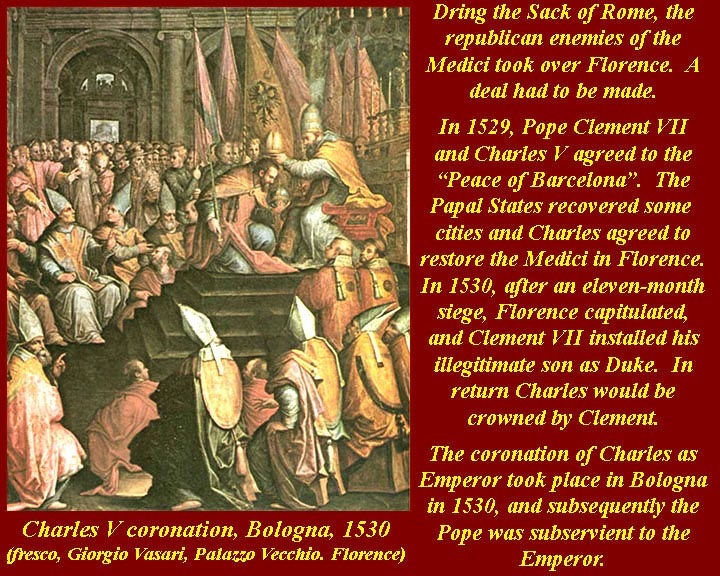
http://www.mmdtkw.org/RenRom0823-CharlesVCoronation.jpg
http://www.mmdtkw.org/RenRom0823a-CharlesVCoronation.jpg
Three years after the Sack, Clement and Charles V had patched things up. By the "Peace of Barcelona" (1529) the Papacy recovered some Italian cities and Charles agreed to restore Medici power in Florence; the Medici had been ousted there by republicans who took advantage of the chaotic movements of the imperial forces in the north. (It took an 11 month siege of Florence by an imperial army to break the republic and reinstall the Medici.) In return the pope crowned Charles V as Holy Roman Emperor in 1530 in Bologna, which allowed Charles officially to drop the word "Elect" from his title; it didn't really matter because that word had long since been dropped unofficially.
The "coronation oath" taken by Charles took the form of an interrogation administered by the Archbishop of Cologne in his capacity as Prince-Elector of the Holy Roman Empire. The last question was, "Will you pay due submission to the Roman Pontiff and the Holy Roman Church?" Charles responded, "I will", but he didn't fool anybody.
http://www.mmdtkw.org/RenRom0823b-RomeCityPopulation1.jpg
During the Sack and in the period immediately following, most of Rome's population -- some 45,000 people -- fled to the countryside or to the safety of relatives in other towns leaving only about 10,000 Romans in the city, the smallest number since the early days of the ancient kings of Rome. They didn't stay away long. In fact in the period following the Sack there was population growth fueled by a building boom as the rich families and the Cardinals repaired and refitted their Palazzi and as the Vatican, the Cardinals, the religious orders, and the social, labor, and religious confraternities did the same for their churches and meeting places. The pre-Sack population was about 55,000, and by 1550 population had risen back to 60,000.

